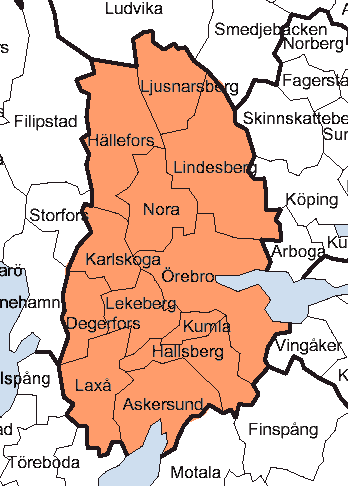The Table of Content


Family Research:






 

Available Help:



|

Örebro County

A horse carriage outside an Ekeby Church. The church is from 1774.
The walls remain from an earlier medieval church.
Photograph by: Unknown
Date: c. 1890
Format: Albumen print
Örebro County It borders the counties of Västra Götaland, Värmland, Dalarna, Västmanland, Södermanland and Östergötland. Örebro County consists in the province of Närke, the western half of Västmanland and minor parts of eastern Värmland and northeastern Västergötland.
Comment: The provinces of Sweden, landskap, are historical, geographical and cultural regions. They have no administrative function, but remain historical legacies and the means of cultural identification.
Örebro County has 275,000 inhabitants and lies at the demographic centre of Sweden. Half the Swedish population lives within a 200 km radius, and it was here in this county that Alfred Nobel wrote his famous last will and testament. The county´s central location has prompted numerous logistics and communications companies to base their operations there. 
Örebro is home to some major exporters, including ABB, Ericsson and Atlas Copco. In 2006, the total air freight leaving the county amounted to 24,519 tonnes, an increase of 52% compared to 2005 – by far the highest annual growth rate in business operations anywhere in Sweden. Ericsson produces base stations in Örebro County; Dyno Nobel Europe manufactures ammunition there, and Atlas Copco has concentrated its world-beating mining expertise in the region. Well-known international businesses, including Coca Cola, Ford Scandinavia and Hitachi also have central warehouses in Örebro.
Örebro University, which has 14, 500 students engaged in studies and research, also maintains close ties with industry.
This Swedish society is governed on three different levels:
1. The State:
On the national level there is the Parliament (Riksdagen), the Government (Regeringen) and State bodies such as the Department of Finance, the Department of Social Welfare and the Department of Agriculture.
The County Administrative Board is the State representative in the county. One of the main functions of the County Administrative Board is to direct and coordinate regional planning. Its Executive Committee consists of the county governor and 14 members appointed by the County Council.
2. The County Council (elected by the county residents):
The County Council, like the County Administrative Board, operates on a regional level. The County Council, however, is an authority elected directly by the inhabitants of the county. The County Council is responsible for health and medical care, public dental care, support and services for the disabled, education and cultural acitivites. There are about 8 500 employees. The County Council is also the joint owner of certain county companies and foundations, such as the Development Company, County Public Transport and the County Theatre.
3. The Municipal Councils:
The municipal councils operate on the local level. The Councy of Örebro has 12 municipal councils. Each municipal council is responsible within its own area for activities such as day nurseries, schools, care of the elderly and housing.
Since 1992 the municipalities have been responsible for home medical care and the nursing homes, although even there the County Council provides the services of doctors. Each of the three County Council hospitals has a geriatric clinic for care and rehabilitation. The aim is to rehabilitate the patients when possible so that they can return home. For patients who do not need twenty-four hour hospital attention there are wards for daytime medical care. These wards provide physiotherapy, occupational therapy and testing of technical aids. Outside the geriatric clinics, the municipalities are responsible for day care.
Financing (how the money is spent):
It costs SEK 4,6 billion each year to run the County Council. The work of the County Council is funded mainly through taxes. Out of every SEK 100 a tax payer earns, about SEK 11 is dedicated towards County Council tax. Health and medical care accounts for almost 87 per cent of the County Council´s costs. The County Council contributes to the county´s cultural activities. The County Council supports the County Theatre, County Music, the County Museum, the County Library and other groups such as sports clubs, amateur theater groups. Trade and industry are supported through the Development Company Almi Företagspartner AB. Together with the 12 municipalities the County Council owns the County Public Transport.
How the Money is Distributed:
Health and medical care 87,2%
Regional Development 4,4%
Investments 3,1%
Dental care 2,5%
General matters 1,6%
Research 1,2%
  
|